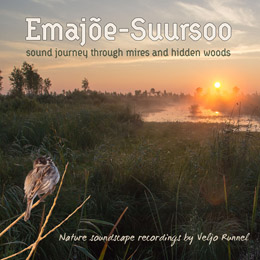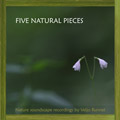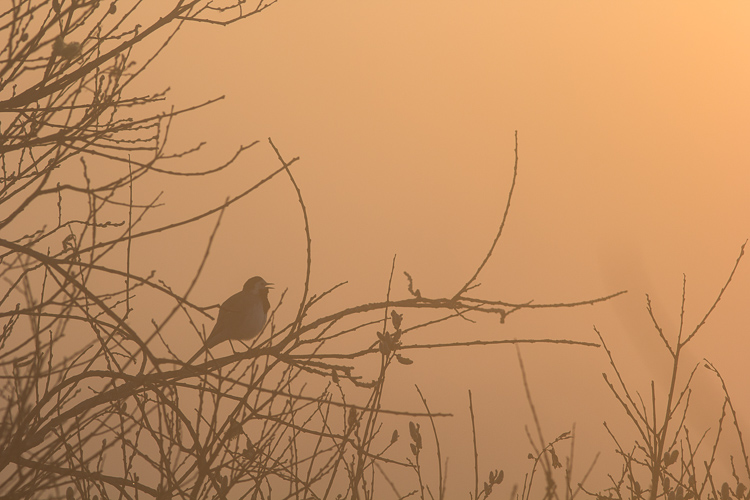

Running Time:
60 min
Release Date:
September 2014
Recording Location:
Emajoe-Suursoo wetlands, Estonia
If you like this album,
we also recommend:
Sound Journey to Emajoe-Suursoo
Emajoe-Suursoo is a vast area of mires, waterways and small forested higher grounds in the middle of inaccessible wetlands in Estonia, a small country by the Baltic Sea.
This is the delta of the River Emajogi, its waters flowing to Lake Peipsi, bordering Russia. The whole area covers more than 200 square kilometres, being one of the largest wetlands in Estonia.
In spring it comes alive with all kind of creatures. Waterfields, reedbeds, swampy mires and forested bog-islands offer plenty of resources for many species. Human disturbance is very low, and it is a perfect place for eagles and other solitary animals.
This is a rich and sonorous recording, featuring the spectacular biodiversity of this remote habitat.
Veljo comments:
"Some of the recording locations I visited for the first time in winter, when it was easier to find access routes and assess the potential of landscape. When the spring arrived, I visited the same spots several times. Carrying the gear through swampy, mosquito-infested areas was not an easy task, but I felt that just being there and listening to the soundscape was a deeply rewarding experience."
"Water is a rich and interesting source of wildlife sounds. I liked to set up the microphones near the water’s edge, so I could record the splashing of fishes, toads and beavers, plus the very delicate sounds from water; small bubbles popping and other inanimate sounds."
"On one occasion, after I had set up the microphones and left, a White-tailed Eagle landed just next to my equipment in a tree. Although the great bird didn’t make a sound, for me the recording is “the eagle piece” and has a special memory."
Audio sample of this album
|
1. |
Morning in the Wetlands |
13.49 |
|
2. |
Reeds and Bushes |
4.43 |
|
3. |
Over the Water |
2.37 |
|
4. |
Edge of the Woodland |
9.48 |
|
5. |
Flycatchers on Bog Island |
18.18 |
|
6. |
Morning Chorus with Woodpeckers |
10.46 |
Track notes:
1. Morning in the Wetlands
There is a stream running through the swampy area. Common Snipes are vocalizing and making strange sound with their tailfeathers while taking display-flights. European Toads are calling softly in water. Reed Bunting and Whinchat are singing in grasses. From time to time we hear rattling call of a Garganey and whistling wingbeats of a Goldeneye. In background the bubbling and hissing sounds from a lek of Black Grouse can be heard and there is continuous presence of European Cuckoos in soundscape.
2. Reeds and Bushes
Nearby in reeds and bushes Sedge Warbler, Willow Warbler, Whitethroat and Reed Bunting are singing. A colony of Black-headed Gulls can be heard in distance. Occasional croaking call belongs probably to Common Pochard.
3. Over the Water
A flock of Bohemian Waxwings are making high-pithced trilling sound as they fly over Apna river. These birds are not staying here, they travel from wintering grounds to breed in taiga and tundra areas of Scandinavia and Siberia.
4. Edge of Woodland
Wood Warbler’s loud trilling song is filling the grove at the border of mire and forest on a bog-island. Somewhere high in trees White-tailed Eagles are vocalizing. A Chaffinch is also singing nearby. Constant companions on the sound journey are Cuckoo and Common Snipe.
5. Flycatchers on Bog-island
Pied Flycatcher and Read-Breasted Flycatcher keep changing singing posts near the microphones. A Blackbird is also singing nearby. Occasionally a Woodcock flies over and makes croaking calls. From time to time we can hear excited trilling of female Cuckoos, apparantly drawn by cuckooing of males. Also present in soundscape are Robin, green frogs.
6. Morning Chorus with Woodpeckers
A morning chorus in April. Woodpeckers are still very active and we hear their drumming from nearby bog-islands where there are plenty of dead trees. Also nearby there are Chaffinch, Dunnock, Treecreeper and other songbirds singing. In background there can be heard constant bubbling of Black Grouse, displaying on their lek sites.
Purchase this
album as:
Digital Album
(for immediate download)
Download this album
for as little as
$7.50 -
View Special Deals
(Prices AU$, exGST)
Mp3:
Mp3 is a universal audio format, playable on iPods, computers, media players and mobile phones.
Mp3 is a compressed format, allowing smaller filesizes, offering faster download times and requiring less storage space on players, but at some expense to the audio quality. Many listeners can't really hear the difference between mp3 and full CD-quality audio, and hence its convenience has lead to it becoming the default option for audio.
Our albums are generally encoded at around 256kbps (sometimes with VBR), balancing optimal audio quality without blowing out filesizes excessively. We encode using the Fraunhoffer algorithm, which preserves more detail in the human audible range than the lame encoder.
Our mp3 files are free of any DRM (digital rights management), so you can transfer them to any of your media technology. You've paid for them, they're yours for your personal use without restriction.
Mp3 files can be burned to disc, either as an mp3 disc, or an audio CD after converting them to a standard audio (.wav or .aif) format first.
FLAC:
FLAC is a high-quality audio format, allowing CD-resolution audio. It is ideal if you wish to burn your files to a CDR, or listen over a high resolution audio system. However files usually require special decoding by the user before playing or burning to disc.
FLAC (Free Lossless Audio Codec) is a LOSSLESS compressed audio format. This means that it preserves the full audio quality of a CD, but optimises the filesize for downloading. Typically, file sizes of around 60% are achieved without any degradation or loss of audio quality from the source files at the CD standard of 16bit/44.1kHz.
Obviously the file sizes are larger than for the mp3 version - usually around 300-400Mb for an album, compared to 100Mb for an mp3 album.
In addition, you'll need to know what to do with the files once you've downloaded them. In most cases you'll want to decode the files to wav or aiff, either to import into programs like iTunes, or burn to CDR. Some programs will play flac files natively.
There is a lot of information about flac online (eg: http://flac.sourceforge.net/)




 Alternate audio link
Alternate audio link 